
The white-capped dipper is an aquatic passerine found in South America. It is a small black bird with white spots. It is found in the Andes from northern Bolivia, through Peru, Ecuador, Colombia to northwest Venezuela.

Axiidea is an infraorder of decapod crustaceans. They are colloquially known as mud shrimp, ghost shrimp, or burrowing shrimp; however, these decapods are only distantly related to true shrimp. Axiidea and Gebiidea are divergent infraoders of the former infraorder Thalassinidea. These infraorders have converged ecologically and morphologically as burrowing forms. Based on molecular evidence as of 2009, it is now widely believed that these two infraorders represent two distinct lineages separate from one another. Since this is a recent change, much of the literature and research surrounding these infraorders still refers to the Axiidea and Gebiidea in combination as "thalassinidean" for the sake of clarity and reference. This division based on molecular evidence is consistent with the groupings proposed by Robert Gurney in 1938 based on larval developmental stages.

Clibanarius is a genus of hermit crabs in the family Diogenidae. Like other hermit crabs, their abdomen is soft-shelled and sheltered in a gastropod shell. Typically marine like all their relatives, the genus includes C. fonticola, the only known hermit crab species that spends all its life in freshwater. The feeding rates of Clibanarius species change with temperature which, given their broad distributions, may have considerable consequences for the stability reef systems as sea temperatures rise in the future.

The Diogenidae are a family of hermit crabs, sometimes known as "left-handed hermit crabs" because in contrast to most other hermit crabs, its left chela (claw) is enlarged instead of the right. It comprises 429 extant species, and a further 46 extinct species, making it the second-largest family of marine hermit crabs, after the Paguridae.
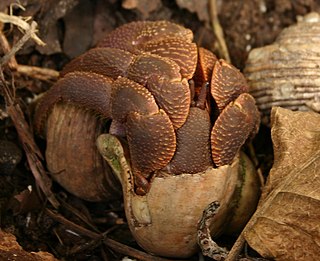
Coenobita brevimanus is a species of terrestrial hermit crab belonging to the family Coenobitidae, which is composed of coastal living terrestrial hermit crabs. From there it belongs to the genus Coenobita, one of two genera split from the family, which contains sixteen species. The Latin origins of the species name, brevimanus, come from the adjective brevis ("small") and the noun manus ("hands"). It is known as the Indos crab or Indonesian crab because it is primarily distributed throughout the Indo-Pacific.

Petrolisthes is a genus of marine porcelain crabs, containing these extant species:
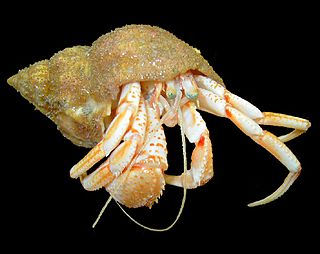
The Paguridae are a family of hermit crabs of the order Decapoda. The king crabs, Lithodidae, are now widely understood to be derived from deep within the Paguridae, with some authors placing their ancestors within the genus Pagurus.
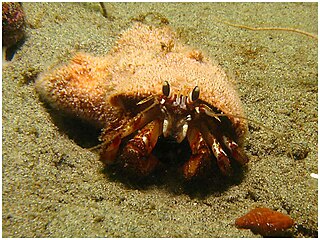
Pagurus is a genus of hermit crabs in the family Paguridae. Like other hermit crabs, their abdomen is not calcified and they use snail shells as protection. These marine decapod crustaceans are omnivorous, but mostly prey on small animals and scavenge carrion. Trigonocheirus and Pagurixus used to be considered subgenera of Pagurus, but the former is nowadays included in Orthopagurus, while the latter has been separated as a distinct genus.

The chestnut-breasted wren is a species of bird in the family Troglodytidae. It is found in Colombia, Ecuador, Peru and Bolivia.

Cabanis's spinetail is a species of bird in the Furnariinae subfamily of the ovenbird family Furnariidae. It is found in Brazil, Bolivia, and Peru.

The curl-crested aracari or curl-crested araçari is a near-passerine bird in the toucan family Ramphastidae. It is found in Bolivia, Brazil, and Peru.
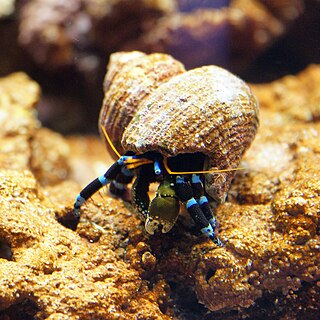
Calcinus is a genus of hermit crabs in the family Diogenidae, containing the following species:

Paguristes is a genus of hermit crab in the family Diogenidae. It includes the following species :

Papilio cacicus is a Neotropical butterfly of the family Papilionidae first described by Hippolyte Lucas in 1852. It is found in Colombia, Venezuela, Ecuador and Peru.

Dismorphia crisia, the crisia mimic white or cloud forest mimic-white, is a butterfly in the family Pieridae. The species was first described by Dru Drury in 1782. It is found from northern Central America to Bolivia and the Amazon basin.

Periscelididae is a family of flies.

Aniculus maximus, the hairy yellow hermit crab or large hairy hermit crab, is an aquatic hermit crab of the family Diogenidae.

Lysmatidae is a family of caridean shrimp in the order Decapoda.
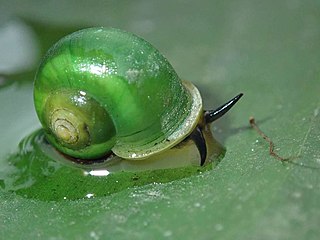
Bourciera is a genus of neotropical terrestrial gastropod mollusks or land snails in the family Helicinidae. All species in the genus have an operculum.
Aniculus hopperae, also known as reticulated Hawaiian hermit, is a species of hermit crab in the family Diogenidae from the Pacific Ocean. The specific name hopperae honors Carol N. Hopper from Waikīkī Aquarium.



















